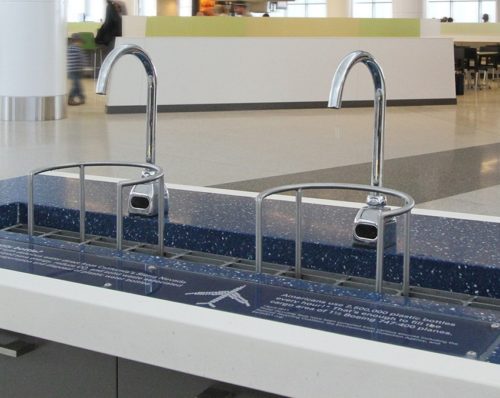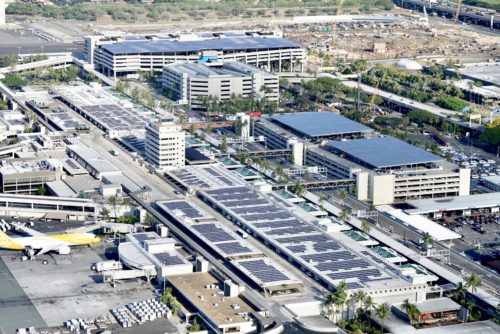
Our story about airports and airlines getting rid of single-use plastics first appeared on CNBC.
Business and leisure travelers concerned about climate change and “flight shame” may do their part by purchasing carbon offsets and adjusting the number of trips they take on airplanes.
Airports and airlines are trying to save the planet too with a wide range of sustainable initiatives that include cutting down the use of single-use plastics and making reusable water bottles essential travel amenities.
BYOB at SFO Airport

In 2019, San Francisco International Airport (SFO), launched an ambitious Zero Waste Concessions Program designed to significantly reduce the amount of single-use disposable plastics used at the airport.
Noting that in 2018 nearly four million slow-to-biodegrade plastic water bottles were sold at the airport, in August 2019 SFO became the first airport in the nation to ban the sale of single-use plastic water bottles.
SFO now actively encourages each passenger to bring their own reusable water bottle with them to the airport and get free water from one of the hydration stations in the terminals.
Bottled sodas, teas and juices are currently exempt from the policy. And bottled water is still being sold, but only in approved packaging made from recyclable aluminum or glass, or in compostable packaging.
Single-use plastics banned at other airports too
Airports in a growing number of other cities in the United States, and around the world, are getting serious about sustainability projects that are good for the environment and, in some cases, the bottom line.
“Whether through their participation in the Airport Carbon Accreditation program, implementation of more sustainable business practices, or even by the elimination of drinking straws and other single-use plastics, airports are taking a variety of approaches to be good neighbors in their communities,” said Scott Elmore, Vice President, Communications & Marketing for Airports Council International – North America
In February 2019, Glasgow Airport offered all 5,300 people working in an around the airport free, reusable bottles.
In September 2019, Dallas Fort Worth International Airport (DFW) announced a campaign to phase out all single-use plastic straws at the airport.
In October 2019, the Airports Authority of India (AAI) announced that at least 55 airports in the country had banned single-use plastic items such as straws, plastic cutlery and plastic plates.
And January 1, 2020, is the deadline for Dubai’s two airports, Dubai International Airport (DBX) – the world’s busiest airport for international travelers – and Dubai World Central Airport (DWC) to be entirely free of single-use plastics such as plastic cutlery, drinking straws, meal packaging and bags.
“Along with our partners, including global brands such as McDonalds, Costa Coffee and Starbucks, we are committed to not only removing single-use plastics but in their place providing appropriate and importantly sustainable alternatives,” said Eugene Barry, Dubai Airport’s Executive Vice President – Commercial, in a statement.
Barry says finding replacements for plastic bottles remains a challenge for the airports, so for now bottle recycling efforts are being beefed up.
Going forward, a bill passed by the Atlanta City Council and waiting for the mayor’s approval is set to ban single-use plastics in the city and at Hartsfield Jackson Atlanta International Airport (ATL) by the end of 2020. Following the new law shouldn’t be too much of a reach: ATL’s guidelines for increased sustainability already seek to divert 90% of the airport’s total waste from landfills.
Not all airports are nixing the plastic water bottles, though.

In its food court, Portland International Airport (PDX) eliminates a great deal of plastic with its Green Plate Program that gives travelers the option of having meals served on reusable plates with reusable utensils.
But the airport’s environmental team hasn’t pressed to impose a ban on plastic bottles because “not every traveler chooses to tote around what can sometimes be a very expensive refillable bottle,” said PDX spokesperson Kama Simonds, “Further, what if travelers to our airport were unaware of the ban? This could have unintended consequences of either leaving folks with less hydration and/or potentially having a sugary drink as the option, which isn’t healthy.”
Airport vendors and airlines doing their part
HMSHost, which operates dining venues in more than 120 airports around the world, says it is on track to honor its commitment to eliminate plastic straws in its North American operations by the end of 2020.
The company has already eliminated plastic cocktail stirrers and currently only provides straws on request in its casual dining restaurants.

In September, Alaska Airlines kicked off a “FillBeforeYouFly” initiative, asking passengers to help reduce the use of single-use plastic bottles inflight by bringing their reusable water bottles to the airport and filling them at airport hydrations stations before their flight.

In November, Scandinavian Airlines (SAS) introduced sustainable meal packaging that includes paper with a coating made of organic plant-based plastic instead of oil-based plastic as well as cutlery made of plant-based plastic.
And earlier this year, Air New Zealand removed individual plastic water bottles from its Business Premier and Premium Economy cabins and switched to compostable plant-based coffee cups made from paper and corn instead of plastic.

The airline is encouraging passengers to bring their own reusable cups on board aircraft and into lounges. And, in a truly tasty move, ANZ is running a test program to serve coffee and ice-cream in edible, vanilla-flavored cups made by New Zealand-based twiice.






